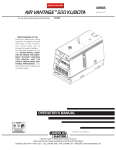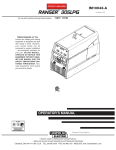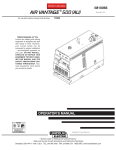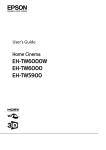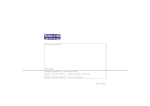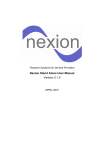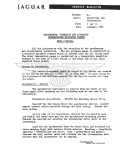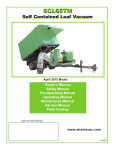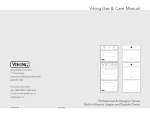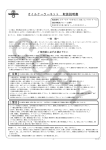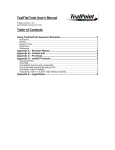Download FishPlant System User Guide
Transcript
™ FishPlant System User Guide FishPlant Family Unit FishPlant Production Unit www.fishplant.co.uk Contents Introduction2 Sourcing Your Fish 2 How Your System Works 3 Starting The System4 Stocking Your FishTank 5 Planting In Your PlantBed 7 Feeding The FishPlant 8 Water Quality9 FishPlant Maintenance 11 Harvesting Fish13 Notes14 Food Fish15 Information on pages 15 - 18 reproduced with kind permission of Aquaponics UK. Family Unit Production Unit Introduction AQUACULTURE + HYDROPONICS = AQUAPONICS Your FishPlant system is an aquaponic system, combining aquaculture and hydroponics. You are going to raise fish and grow plants in an enclosed ecosystem, with beneficial microbes providing the bridge that converts the fish waste to usable plant nutrients. When we feed the fish, we are also feeding the bacteria and the plants. In relation to a natural ecosystem, the FishPlant is small and simple, so we must help to maintain the correct balance. Fish provide waste – Bacteria convert waste to nutrients – Plants clean water. Sourcing Your Fish The first decision you have to make is what fish to raise. This depends on whether you intend to eat them or just keep them for pleasure. While the principle of aquaponics is primarily to grow food, it may be that you prefer to raise ornamental fish such as koi carp or goldfish and just eat the plant produce. If this is the case you are likely to use lower fish densities (hence feed less) and therefore the amount of plants it is possible to grow will be reduced. If you are planning to eat your fish, there are a number of species to choose from such as carp (common or mirror) and perch to name just a couple, but the one we strongly recommend, certainly if you are new to fish-keeping and/or aquaponics is Nile tilapia (Oreochromis niloticus). It is a tasty fish, that is hardy and tolerant, which can be kept at a high density and is resistant to disease. With the right conditions they can easily be grown to harvest size in six months. Fish should always be sourced from a reliable and reputable supplier, if in doubt, ask to see any paper work relating to where the fish stock came from. Generally speaking, fish that have been bought for ornamental purposes should not be eaten as they may have been treated with harmful additives. When buying fish that are held in a tank, avoid those that are being kept with sick fish or those that look stressed. When transporting your fish back to your fish plant system, try to keep stress to an absolute minimum. If you want to raise edible varieties of fish you will require CEFAS registration (free to register) as an aquatic holding. Please go to www.defra.gov.uk/aahm for information and RW2 registration form or www.fishplant.co.uk for more details. FishPlant System – User Guide 2 How Your System Works The PlantBed of your FishPlant system is based on the ‘Flood & Drain’ (or ‘Ebb & Flow’) hydroponic technique – the ‘flood’ bringing water and nutrients to the plants roots, the ‘drain’ drawing fresh air (oxygen) into the root-zone. The water pump runs constantly and the AutoSiphon controls the flooding and draining. The AutoSiphon cycle starts when the water level in the PlantBed passes the overflow point of the downspout and starts to siphon back into the FishTank – this also helps oxygenate the water for the fish. The siphon will flow faster than the inlet flow rate and will drain the PlantBed until the water level reaches the siphon break point. Then it will start flooding again (see diagrams below). 1. The water in the PlantBed rises until it reaches the overflow. 2. The water is then siphoned back into the FishTank until the PlantBed is empty and air gets into the Siphon. 3. The PlantBed fills up with water again and repeats the cycle. 3 FishPlant System – User Guide Do I Need Extra Water Circulation? The Flow Fitting also directs some of the pumped water directly back into your FishTank which ensures constant circulation and helps oxygenate the water for the fish. If you add beds or nursery tanks to your system at a later date, a second circulation pump may be required then. Do I Need Extra Aeration? High oxygen levels in the water are important for healthy fish so you may wish to consider a FishPlant Air-pump and FishPlant Air-stone for your system. We strongly recommend this for heated systems as warm water naturally holds less oxygen. Do I Need A Heater? This depends on the fish species you plan to keep and the environment your system is in, for tilapia you will certainly need one (tilapia require water temperature of 24-32°C), such as the FishPlant 300w Heater. www.fishplant.co.uk has tables which show ideal temperature ranges for a number of fish species. Starting The System Fill your FishTank with water to 10cm from the rim: Family Unit - approximately 300 litres. Production Unit - approximately 800 litres. With all valves on your flow-fitting fully open (in line with the pipe) switch the pump on. Water will start pouring into your PlantBed through the Inlet and the SplashGuard and you should also notice circulation of water in the FishTank. water circulates as systems run FishPlant System – User Guide 4 The PlantBed will fill and water will start flowing back into the FishTank through the AutoSiphon. Monitor it closely and if it does not start siphoning (the difference between overflow and siphon should be obvious) within a couple of minutes, close the return valve a fraction – keep adjusting until you have it right. You should always have some water flowing directly back to the FishTank through the return valve. Once you are satisfied the system is cycling properly it is advisable to check the pH of the water. Proceed to add the de-chlorinating solution from your FishPlant Starter kit and leave to run for 24 hours. Follow the instructions with the FishPlant Starter kit to successfully colonise your system with the necessary bacteria – a pH above 7.0 (optimum 7.8) will help with this process, if it is above 8.0 it should be adjusted down slightly (use FishPlant pH Down for best results). Add the Live Filter Bacteria directly into the foam filter of the SplashGuard. You should allow a week for this process. Keep an eye on the AutoSiphon to ensure it is cycling properly. If any remaining dust from the pebbles settles out in the tank, stir it up and it will get trapped in the PlantBed. It is advisable to check the pH again now. When you are happy the bacteria are colonising the system you are ready to begin stocking and planting your FishPlant system. Stocking Your FishTank Your FishPlant system should be stocked gradually, allowing the system to develop in harmony with the fish biomass. A target biomass should be about 1kg per 100 litres of water. So for the Family Unit about 3kg of fish with a maximum of 3.5kg, the Production Unit you should be able to stock up to 8kg of fish, however, with the standard two PlantBeds we would recommend a target biomass of 6kg going up to a maximum of 7kg. You should put in a small number of fish at regular intervals, so that by the time the first fish are at a size fit to eat, you are at or about your maximum biomass: So, for example, with tilapia you could stock: Family Unit 5 fish every 6 weeks, Production Unit 5 fish every 3 weeks or 10 fish every 6 weeks. With an average start weight of 20g and a minimum harvest weight of 350g. By six months under good conditions, the biomass based on average weights of the fish, might have reached: Family Unit 3.5kg and 20 fish; Production Unit 7kg and 40 fish. 5 FishPlant System – User Guide As with all living things some would grow faster than others so you may be able to harvest the first fish at about 5 months. From this point on you should be able to harvest 5 fish from the Family Unit or 10 fish from the Production Unit, every six weeks, so the biomass will fluctuate between 3 to 3.5kg in the Family Unit and 6 to 7kg in the Production Unit. With some slower growing cold-water species, you may have to plan the stocking programme over 12 months. Biomass and number of fish using ‘Multiple Batch Production’ 25 4.0 FP Family 3.0 15 2.0 10 Biomass (kg) Number of fish 20 1.0 5 0 0 0 6 12 18 24 30 36 42 Weeks Biomass and number of fish using ‘Multiple Batch Production’ 50 8.0 FP Production 6.0 30 4.0 20 Biomass (kg) Number of fish 40 2.0 10 0 0 0 6 12 18 24 30 36 42 Weeks When stocking fish it is extremely important that the temperature of the culture water is similar to that in which the fish arrive. A temperature difference of greater than 2 degrees in 1 hour, will shock the fish, potentially fatally. Place the bags containing your new fish inside the fish tank to allow the water temperature to adjust gradually before opening the bags, gradually mixing the water and then finally releasing your fish into the tank. During their first 48 hours in the tank, closely monitor the fish and avoid causing any unnecessary stress. To start with, avoid feeding the fish, however after a few hours introduce a few pellets and observe their feeding behaviour. For the next 48 hours, continue to feed the fish sparingly, and only if they are eating all the food within a minute or so of it entering the tank. FishPlant System – User Guide 6 Planting In Your PlantBed Ideally the plants you put in your PlantBed will have been started in a pre-formed plug such as ROOT!T propagation sponges, DO NOT USE STONEWOOL as the fibres may cause a problem in the fish gills. They should have the first roots visible outside the plug and at least 3 or 4 true leaves, but the better rooted they are, the quicker they will establish. If you are using plants started in compost or soil, you will have to gently wash as much as possible off the roots before planting. Leave a few days after putting the first fish in before planting your system and it is a good idea to only plant up a small area, planting up more of the PlantBed only when you stock with more fish (the bacteria will do their job irrespective of plants). Scoop out a handful of pebbles place the plants in position and then replace the pebbles so the plug is just below the level of the pebbles, if the plant is ‘barerooted’ plant it only slightly deeper than if it was in compost or soil, ensuring the roots are deep enough for the ‘flood’ level to reach them. In the early stages we only suggest you grow salads, leafy vegetables and herbs, but when your system is more mature you may wish to experiment with more demanding plants. Plant Care Please see www.fishplant.co.uk for more advice on propagating plants for your system. The conditions for the tops of the plants should be the same as in normal growing. DO NOT USE SYSTEMIC PESTICIDES as they will be toxic to the fish. ONLY use physical modes of pest and disease control. Many salads and leafy vegetables and herbs are described as ‘cut and grow’ so can be continuously harvested but even these will need replacing occasionally. To remove plants, take firm hold of the whole plant and gently ease as much of the root system out as possible, gently knocking the pebbles off as you go. 7 FishPlant System – User Guide Feeding The FishPlant When you are feeding your fish you are also, indirectly, feeding the plants! Hence there is a link between how much you are feeding and how many plants will grow. The maximum feed level a fully mature PlantBed will be able to process effectively is 30g per day and this is what limits the fish biomass. DO NOT FEED MORE THAN YOUR FISH WILL EAT. They should be fed sparingly at first, but once established you should be feeding between 1% and 3% of FishTank biomass per day, so: 5 fish at 20 grams each (100g total) will only require between 1 to 3 grams of food per day; 30 fish with an average weight of 100 grams (3kg total) could be fed 30 to 90 grams per day – but this should be limited to 30 by the size of the PlantBed. Once the system is fully stocked and functioning, extra PlantBeds could be added to increase the food allowed and hence the speed the fish would grow. The daily feed ration should be split into ideally three feeds, morning, midday and evening, whenever possible and any left in the tank after 5 or 10 minutes should be removed. We recommend the use of FishPlant FishFood for all omnivorous species such as tilapia, carp (both edible and ornamental) and goldfish, as well as some cold-water carnivores like perch. FishPlant FishFood is a complete balanced feed, with high levels of protein and vitamins for rapid growth and good health and is suitable for fish intended for human consumption. There are two sizes of pellet available, the smaller for young fish (up to about 70g) and the larger for more mature fish, but if you are stocking over a period of time to get a continuous supply (as previously described) you will find you are feeding a mix of both, but with higher ratios of the larger pellet. FishPlant System – User Guide 8 Water Quality Maintaining a healthy system for fish, bacteria and plants, is all about keeping things in balance. It is sometimes a compromise between what is ideal for the different living organisms. This is why monitoring water quality is always important, but particularly so in the early weeks, while the system is establishing itself. It is a good idea to record all results and any adjustments and additions made to the water, both for your own reference and to make it easier for us to help if you require support. A sample table is available at www.fishplant.co.uk There are a number of different factors relating to water quality we must be aware of. How to monitor them and what to do are explained below. Dissolved Oxygen Fish use oxygen for respiration, therefore having dissolved oxygen above 5mg/ litre is vital in a FishPlant system. Testing for dissolved oxygen is difficult and expensive, however, by ensuring all the other water quality factors are okay and there is sufficient water movement and aeration (and the water temperature is not too high) we can be confident there is enough dissolved oxygen in the water. The return valve on the Flow Fitting will constantly move water around your tank, and the AutoSiphon draining into your FishTank both help increase dissolved oxygen. Water will hold less dissolved oxygen when it is warmer, so if you are heating the FishTank above 16°C (e.g. for tilapia) we strongly recommend additional aeration – a FishPlant Air-pump and FishPlant Air-stone – though you may wish to add them even for cold water. Acidity or ‘pH’ Acidity is measured as ‘pH’ and is a scale of 1-14, with 7 being neutral, 1 being most acidic and 14 being most alkaline. In your FishPlant System you MUST keep the pH between 6 and 8. Once the system is running successfully, the pH is likely to FALL and should be monitored and adjusted regularly. The FishPlant ‘Fish Care’ water quality test kit contains a pH test, and also an alkalinity (or KH) test that helps monitor how stable the pH is. Once your system 9 FishPlant System – User Guide is running effectively, the pH test is the one most used, there is also a separate FishPlant ‘pH Test kit’. The pH should be adjusted up using FishPlant pH Up, this is food grade potassium hydroxide in a relatively weak dilution for safe use, but should still be kept out of the reach of children. The potassium in it is available to the plants to use. Dilute further with either topping up water or water from the FishTank and pour back through the PlantBed. Water ‘Hardness’ Our water supply is normally described as either ‘soft’ or ‘hard’. This depends on how much dissolved solids (mainly Calcium and Magnesium Carbonates) there is in it. Hardness is often expressed as ‘mg/litre CaCo3’: • Soft water 0-75 mg/litre CaCo3 • Moderately hard water 75-150 mg/litre CaCo3 • Hard water 150-300 mg/litre CaCo3 • Very hard water >300 mg/litre CaCo3 How ‘hard’ your water is, affects many other parameters within your FishTank, especially the ‘pH’ and how likely it is to fluctuate. Very ‘soft’ water may not contain enough calcium for plants to grow well, and very ‘hard’ water can lead to too much calcium building up in the water, than is good for the fish. The FishPlant ‘Plant Care’ water quality test kit contains a ‘General Hardness (GH)’ test, that is measured in °DH. If the water from your supply is less than 3°DH, it may be necessary to add calcium (in the form of either hydroxide or carbonate, please refer to www.fishplant.co.uk for more advice) for the plants and to help stabilise pH. If the GH in the FishTank builds up over time to 30°DH you should start doing partial water changes (not more than 10% at a time) to keep it below. The Nitrification Process The waste that fish produce contains ammonia, which nitrosomonas bacteria convert to nitrite, which in turn nitrobacter bacteria convert to nitrate. Ammonia and nitrite are toxic to fish when they reach high levels, whereas nitrate is the form of ‘nitrogen’ plants need most. So we can see how important it is that the nitrification process works smoothly – this is why we must only stock the FishTank slowly, allowing the numbers of bacteria to increase to cope. Nitrates are safe for fish except at very high levels, so we should not run a system for a long time with no plants, unless we do partial water changes. FishPlant System – User Guide 10 The FishPlant ‘Fish Care’ water quality test kit contains both ammonia and nitrite tests and shows the real danger levels, but we should be aiming for these to both be zero. More fish should NOT be added to a FishTank when either of these is above zero. If either the ammonia or nitrite measurements show dangerous levels for fish, partial water changes should be carried out (NEVER more than 20%). FishPlant Maintenance Plant Nutrients There are 13 mineral nutrient elements vital to healthy plant growth, split into three groups known as ‘primary’, ‘secondary’ and ‘trace’ elements. Of these, all are readily available from water or fish waste in the required amounts, with the exception of iron, and possibly calcium in very soft water. The primary or macro-nutrients are nitrogen (available as nitrates), potassium and phosphorous (available as phosphates). The FishPlant Plant Care Water Quality Test Kit contains a nitrate test and a phosphate test, we should be looking to see the presence of these (but not necessarily in large quantities) in the FishTank water. For healthy abundant plant growth it will be necessary to add iron in a soluble form. FishPlant Iron is a safe source of this iron for fish. Always dilute additives in a bucket of topping up water and pour through the PlantBed. For the first few weeks and for a week or so each time you add new fish, test the ammonia and nitrite levels every day. Daily Tasks Feed the fish. Ideally you will feed the fish three times a day or more. Auto-feeders can be used when on short breaks, but few will do it for a 2 week holiday, and it is better to arrange for someone to come and at least look at the fish every couple of days. Watch the fish when you feed them and do not leave uneaten food in the FishTank. The fish not eating is a good early indicator that something is wrong. Check the system is functioning correctly. Check the AutoSiphon is cycling 11 FishPlant System – User Guide correctly, the pump is working and water is circulating from the Flow Fitting. Also check any additional equipment like heaters and air pumps. Once you know the system this will become second nature and you will tell at a glance if there are any problems. Check and adjust the pH. Again once you know your system, you may find this does not need doing every day, or possibly that you need to do it as often as you feed (it is better to make several small adjustments than one big one. Always add FishPlant ‘pH Up’ in a bucket of water, poured through the PlantBed. Weekly Tasks Water quality testing and recording. The more things you test for and record, the better you will come to understand the system, and the easier it will be to get advice if there are problems. Pest monitoring. The key to successful pest control in plants is early identification, so research common pests of the plants you grow as well. Tidy up. Remove any dead leaves or sick plants and keep things clean and tidy around the system. The water movement should prevent any settlement of solid fish waste, but if there are a couple of still points where settlement occurs, remove solid waste with a net. This will help prevent any disease problems for both plants and fish. Harvest and replant the PlantBed. Herbs and salad leaves will benefit from regular picking and produce more in the long run. Even single harvest plants like ‘head’ lettuce will be better picked as soon as ready. Remember to keep the FishTank running well, you should keep the PlantBed planted accordingly. Top up the FishTank. It should be kept as close to full (10cm from the top) as possible, remembering to check the level when the AutoSiphon has just stopped draining the PlantBed. ALWAYS top up through the PlantBed to help prevent temperature shock. Do partial water changes only when they are deemed necessary. ALL WATER ADDED TO YOUR FishPlant System SHOULD BE LEFT TO STAND FOR AT LEAST 24 HOURS, OR DECHLORINATED. Water loss from the system, by transpiration and evaporation, will be about 10-30 litres per week, dependant on environmental conditions. Monthly Tasks Clean the pump. When the AutoSiphon has just finished draining the PlantBed, switch off the pump, disconnect from the mains and then the Flow Fitting, take FishPlant System – User Guide 12 it out and remove the inlet cover, and take out the impeller (taking care not to drop any seals) and wipe everything down, before putting back. This will help your pump last a long time. Examine fish. This will mean catching a random sample (one at a time), and checking them over for obvious problems and signs of disease, once you are at a stage where you are harvesting fish, you will inevitably catch a few smaller ones in the process – take the opportunity to do this then. Harvesting Fish When your fish have reached a suitable size to eat, they MUST be dispatched as quickly and humanely as possible. Please ensure you have read the fish harvesting section at www.fishplant.co.uk for the most up to date information on the recommended procedures. 13 FishPlant System – User Guide Notes When removing any fish from the tank for whatever reason it is very important to keep stress to a minimum. Use a small net to take fish from the tank and keeping handling of the fish to a minimum. If you do handle the fish directly make sure your hands are wet and that you handle them carefully but confidently and remember to wash your hands thoroughly after every contact. When carrying out sample checks, weigh the fish if possible. The easiest way is to fill a bucket with water from the tank, place it on the scales and set to zero before catching the fish. Repeat the whole process with a fresh bucket of water for each fish. Try and get a representative sample including a range of sizes, and use this to calculate on approximate biomass for the tank. Always add any topping up water for the system through the PlantBed to help prevent temperature shock, this also applies to any water taken from the tank for diluting additives as this will help further equalise concentrations and prevent discomfort to any fish. It is a good idea to keep a water butt or similar container full of clean water for topping up, allowing it to stand for plenty of time before use. FishPlant System – User Guide 14 1. Food Fish – Tilapia Common Name(s): Nile Tilapia, St Peter’s fish Species: Oreochromis Niloticus Tilapia are by far the most popular species in aquaponics. It is a hardy fish; tolerant to fluctuating water conditions and crowding, and resistant to disease. Tilapia are also omnivorous and can be grown very quickly to harvest size with little or no animal protein in the diet. History: Oreochromis niloticus is the most popular species of tilapia for culture. Endemic to Africa and originally farmed in Egypt over 4000 years ago, tilapia is now cultured in over 100 countries and is 2nd only to carp in terms of global aquaculture production. No longer the ‘poor mans fish’ consumer popularity is increasing worldwide and there is now a large market in the US, South East Asia and Europe. Tilapia is a popular choice both for subsistence and commercial farmers due to its amazing capacity for domestication and tolerance of culture conditions. This has led to it being termed the ‘aquatic chicken’ a domesticated source of affordable protein that may be the most important aquaculture species of the 21st century. Physiology: Body compressed and round, species is characterised by regular vertical stripes on the caudal fin. Greyish or black-green colouring with 6-9 indistinct vertical bars. Whitish belly. Diet: Tilapia are omnivorous and, in the wild they feed mainly on phytoplankton, algae and aquatic plants. Complete pelleted diets, specifically tailored to tilapia, are available that are lower in fat than salmonid diets and contain less fish meal and oil in favour of plant based proteins. These diets can be supplemented with plant off-cuts as well as worms, soldier fly larvae, and other invertebrates. Growth Rate: Tilapia can reach a harvest size of 500g after 6 months rearing within the optimal temperature range. Males grow faster and more uniform in size than females, thus all male cultures are preferable, and all male fingerlings are available from all major suppliers. Nile Tilapia: 24-32°C D.O. mg/l 3-10 15 pH Un-Ionised Nitrite Nitrate Units Ammonia mg/l mg/l mg/l 6-8 0-0.04 0-0.4 <50 Hardness mg/l Alkalinity mg/l CO2 mg/l Salinity ppt Chloride mg/l 50-350 50-250 0-30 0-5000 0-5 FishPlant System – User Guide 2 - 2. Food Fish – Carp Common Name(s): Common Carp Species: Cyprinus carpio praC nommo oiprac s Carp are ideal for home food production. They are omnivorous and will eat a huge range iw dare naalso suvery orohardy vinmfish o etolerating ra yehT .noitcudorp doof em of foods including worms and vegetable scraps.llThey yehperiods T .spifayou rcsdecide elbanot tegtoevheat dna smrow gnidulcni sdo very low oxygen levels and will survive cold winter your system. evivrus lliw dna slevel negyxo wol yrev gnitarelot h .metsys ruoy taeh ot ton ediced uoy History: Carp have long been popular as a food fish. They have been reared for over 2000 years in China and were a luxury food for the Romans who kept them in large revo rof deraer neeb evah yehT .hsfi doof a sa ralupop nee purpose built storage ponds. Domestication of carp was spread across Europe by e gral ni meht tpek ohw snamoR eht rof doof yruxul a erew Christian monks who kept the fish in ponds for food, selecting the largest fish for yb epselection, oruE ssalbeit orcaunintentionally. daerps saw prac fo noitacitsemoD .sd breeding and subsequently carrying out artificial Common Carp have now been introduced to roalmost f hsfi every tsegrpart al eofhthe t gworld nitceleand s ,itdisoof rof sdnop ni hsfi eht t currently the third most cultured finfish species globally. .yllanoitnetninu tiebla ,noitceles laicfiitra tuo gniyrrac yltn si ti dna dlrow eht fo trap yreve tsomla ot decudortni neeb Physiology: Long and flat body with large scales. Thick, projecting lips. Two pairs of .yllabolg seiceps hsfinfi deru barbels at the angle of mouth and shorter ones on the upper lip. Colour varies from golden yellow, silver to brownish-green depending the fo sriaponow T minerals .spil gninitcthe ejowater rp ,kand cihTthe.selacs egral htiw ydob t level of penetrating sunshine. Males are smaller than females, carp can grow to a morf seirav ruoloC .pil reppu eht no seno retrohs dna htu maximum length of 1.2m and maximum weight of over 40kg. eht dna retaw eht ni slarenim eht no gnidneped neerg-hsinw Diet: Carp are omnivorous and will eat almost a oanything, t worg saying nac this practhey,shave elamaestrong f naht rellams era selaM .eni preference for consuming invertebrate food such as water insects, insect larvae, worms, .gk04 revo fo thgiew mumixam dn molluscs and zooplankton. Carp will also eat the stalks, leaves and seeds of aquatic and terrestrial plants, and decaying vegetation.gnorts a evah yeht siht gniyas ,gnihtyna tsomla tae lliw dna ,smrow ,eavral tcesni ,stcesni retaw sa hcus doof etarbetrev Growth Rate: The daily growth rate of carp can be citabetween uqa fo 2s-d4% eesof dbody na sweight. evael ,sklats eht tae osla lliw praC Carp can reach 600g – 1kg in 12 months in a heated system. They can survive lower .noitategev gniyace winter temperatures but will take 2-3 times longer to reach harvest size. .thgiew ydob fo %4 - 2 neewteb eb nac prac fo etar htw rewol evivrus nac yehT .metsys detaeh a ni shtnom 21 ni .ezis tsevrah hcaer ot regnol semit 3-2 ekat Common Carp: 23-30°C D.O. mg/l 1-10 ℃ 03-32 :praC nommoC pH Un-Ionised Nitrite Nitrate Hardness Alkalinity CO2 Salinity Chloride Units Ammonia mg/l mg/l ymg/l mg/l mg/l mg/l mg/l etartiN etirti tinilaS edirolhC 2OC ytinilaklA ppt ssendraH t p p l / g m l / g m l / g m l / g m l/g 6.5-9 0-0.04 0-0.2 <50 50-350 50-250 0-30 0-3000 0-5 l/gm 5-0 0003-0 03-0 052-05 053-05 05< 2.0- 16 FishPlant System – User Guide ytinilaS edirolhC ℃13-4 :hcreP naeporuE 2OC ytinilaklA ssendraH etartiN etirti 3. Food Fish – Perch h Common Name(s): European Perch Species: Perca fluviatilis European Perch is one of the best tasting freshwater ylevitcfishes nitsidwith htidistinctively w sehsfi rflavoured, etawhserf gnits delicate flesh and relatively few bones. Nativeyto ehthe t ,UK, KUthey ehtolerate t ot eaviwide taN range .seofnob wef temperatures and despite being carnivorous,ncan grow well on a diet supplemented ac ,suorovinrac gnieb etipsed dna se with home-grown live feeds such as worms. .smrow sa hcus sdeef evil nworg-emoh nretsato E extensive ni erutlucpond dnoculture p evisninetEastern xe ot denfinoc History: Perch farming has typically been confined Europe and France. The fillets are a delicacy indn countries a muigsuch leB as saBelgium hcus and seirtnuoc ni ycaciled Switzerland retailing at double the price of trout morand f sresalmon, ffus tekbut ramtheehmarket t tub ,suffers nomlafrom s dna tuort irregular supply and an over reliance on wildecapture. This has provided a niche ht ni ehcin a dedivorp sah siin hTthe .erutpac dli market for farmers seeking to diversify from traditional cultured species where margins snigram erehw seiceps derutluc lanoitidart m are tight. The European Union has therefore funded research into perch aquaculture e ruteconomic lucauqa development, hcrep otni hand craethe ser dednuf erof since the 1990’s, in line with policy for social and e h t d n a , t n e m p o l e v e d c i m o n oce dna laicos number of intensive recirculating perch farms has started to increase. .esaercni ot detrats sah sm Physiology: Moderately deep body with rough edged scales. Short head and blunt, ,tnulb dna daeh trohS .selacs degde hguor rounded snout. Teeth are small but numerous. Colour ranges from grey-green on the ehwith t nodark nevertical erg-yerbars g macross orf sethe gnaupper r ruoloC .suore upper body to green-yellow for the abdomen repporange. u eht Itssisoarcrelatively a srab small lacitrefish v kand rad htiw nem sides. Pelvic, pectoral and anal fins are generally can reach sizes of 35-50cm length and up to d 5kg The na weight. hsfi llam s temperate ylevitaler arange si tI for.egnaro yllarene Perch lies between 4-31°C with an optimum rof of22°C. egnar etarepmet ehT .thgiew gk5 ot pu .C°22 fo m Diet: Perch are carnivorous with a preference in the wild for small fish. Trout diets are recommended, however this can be heavily supplemented era steidwith tuorlive T .hinsects sfi llamsuch s rofasdliw eht ni ec worms. sa hcus stcesni evil htiw detnemelppus yl ℃ 03-32 :praC Growth Rate: Perch require around 10 months to reach a harvest size of 100g at tinilaSthan di0ro hC nhilaakh lAcaesr soetnsdh ratn Ho 2zO taemales g 0l1 fo ethus isCtan seall vyrtaifemale optimum temperature. Females grow 20%yfaster and tpp l/gm l/gm l/gm l/gm stock will be ready to harvest after just 8 months. elamef lla na suht dna selam naht retsaf 5-0 0003-0 03-0 052-05 053-05 .shtno ℃42-61 :hcreP European Perch: 16-24°C D.O. mg/l 5-13 17 pH Un-Ionised Nitrite Nitrate Units Ammonia mg/l mg/l mg/l 6-9 0-0.02 0-0.1 <50 ytinilaS edirolhC 2OC ytinilaklA ssendraH Hardness tpp Alkalinity l/gm COl2/gm Salinity l/gm Chloridel/gm mg/l5-0 mg/l mg/l ppt 0051-0 02-0 052-05 mg/l 053-05 50-350 50-250 0-20 0-1500 0-5 FishPlant Family Unit – User Guide ℃61-21 tuorT od4.Fish - –4Trout Food Fish Name(s): mmon Common Name(s): Rainbow Trout Rainbow Trout Oncorhynchusmykiss mykiss pecies:Species: Oncorhynchus A popular and well known cold-water food fish. Rainbow trout are relatively ular and well known cold-water food fish. Rainbow trout are relatively hardy, fast growing and tolerant of handling, however trout require good water fast growing and ofbehandling, however require good water quality and fasttolerant flow-rates to reared at high densities. trout If you would like to and fast totherefore be reared atdoing highsodensities. If you would like to growflow-rates trout we would suggest only in the large FishPlant production at no moresuggest than 0.5kg doing per 100 litres of water. rout we would unit therefore so only in the large FishPlant m at no more than 0.5kg per 100l of water. History: Since the late 19th Century Rainbow trout has been introduced to all y: Since the late 19th Century Rainbow fishing trout and hasfor food. beenFollowing introduced continents except Antarctica, for recreational the to all ents except Antarctica, for recreational fishing and for Following the development of the flow-through tank system and pelleted feedsfood. in the early 1900’s, the trout aquaculture industry has grown exponentially. Rainbow trout is by far the most pment of the flow-through tank system and pelleted feeds in the early 1900s, the widely farmed trout the world, mainly becauseRainbow it is a prized food is fishby andfar because it is quaculture industry hasingrown exponentially. trout the most relatively easy to culture. farmed trout in the world, mainly because it is a prized food fish and because it is ly easy Physiology: to culture. Long, elongated body. Adipose fin is present. Colouration is blue to olive green above a pink band along the lateral silver below. Back, sides, head and ology: Long, elongated body. Adipose finline is and present. Colouration is blue to olive covered with small black spots. Trout can withstand wide ranges of temperature above afinspink band along the lateral line and silver below. Back, sides, head and variation (0-27 °C) but optimum growth occurs between 12 and 16 °C. At water vered with small black spots. Trout can23-30 withstand wide ranges of temperature Common ℃ becomes inefficient and much of temperatures above 22°C, a trout’sCarp: digestive system n (0-27 °C) but optimum growth occurs between 12 and 16 °C. At water the feed ends up as waste in the water. Un-Ionized pH Nitrite Nitrate Hardness Alkalinity CO2 Chloride Salinity Ammonia ratures above 22°C, a trout's digestive system becomes inefficient and much of nits mg/l mg/l mg/l mg/l mg/l mg/l ppt mg/l Diet: Trout are carnivores and in the wild, will consume a large range of organisms d ands up as waste in the water. 5-9 0-0.04 0-0.2 <50 insects, 50-350 50-250 small 0-30fishes0-3000 such as aquatic and terrestrial molluscs, crustaceans, and 0-5 Trout are carnivores and in give the the wild, consume aorange-pink large range of Pelleted organisms freshwater shrimp which fleshwill its characteristic colour. as aquatic andbeen terrestrial insects, molluscs, crustaceans, small fishes diets have modified and improved over the years, and are widely available. Dueand European Perch: 16-24℃ to the carnivorous nature of trout, these diets are typically high in energy/lipids and ater shrimp which give the flesh its characteristic orange-pink colour. Pelleted Un-Ionized pH Nitrite Nitrate of Hardness Alkalinity Chloride Ammonia contain relatively large amounts fish the oil. years, 2 ave been modified and improved over and areCO widely available. Salinity Due nits mg/l mg/l mg/l mg/l mg/l mg/l ppt mg/l carnivorous nature of trout, these diets are typically high in energy/lipids and -9 0-0.02 Rate:0-0.1 <50 50-350 0-1500 0-5 Growth Food market fish size can be reached50-250 in 9 months0-20 (30-40cm) but ‘pansized’ n relatively amounts oil. fish,large generally 280-400ofg,fish are harvested after 12-18 months. h Rate: Food market fish size can be reached in 9 months (30-40cm) but 'pansh, generally 280-400 g, are harvested after 12-18 months. pH nits -8.5 Common Carp: 23-30°C Rainbow Trout 12-16℃ D.O. pH Un-Ionised Nitrite Nitrate Hardness Un-Ionized mg/l Units Ammonia mg/l mg/l mg/l mg/l Nitrite Nitrate Hardness Alkalinity Ammonia 5-12 0-0.1mg/l<50 50-350 mg/l mg/l mg/l 6.5-8.5mg/l 0-0.02 0-0.02 0-0.1 <50 50-350 50-250 Alkalinity CO2 mg/l mg/l CO2 Chloride 50-250 mg/l 0-20 mg/l 0-20 FishPlant System – User Guide 0-1500 Salinity ppt Salinity 0-1500 ppt Chloride mg/l 0-3 0-3 18 Provide your fish and plants with the best growing conditions ™ www.fishplant.co.uk Fish and Plant Feed Nutrient Control Growing Media Water Management Starter Kits DESIGNED FO R The Latest Innovation in Propagation For your FREE Successful Propagation Guide, to find your local ROOT!T stockist and much more visit www.propagateplants.com Propagators 19 Propagation Kits Growing Media Rooting Gel Plant Feed FishPlant System – User Guide Heat Mats Lighting Systems




















